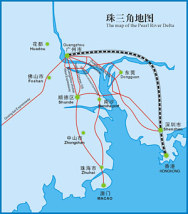The Pearl River Delta Economic Zone is one of China’s leading economic regions and a major manufacturing center. It is located at the Pearl River estuary where the river enters the South China Sea. The zone is formed by 9 cities, namely Guangzhou, Shenzhen, Foshan, Zhuhai, Jiangmen, Zhongshan, Dongguan, four districts and counties of Huizhou and four districts and counties of Zhaoqing. The Pearl River Delta Economic Zone started to take off since the reform and opening up policy was adopted in the late 1970s. The Pearl River Delta Economic Zone started producing labor-intensive consumer goods such as food and beverages, toys and clothes in early 1980s. After 1985, industrial relocation, mainly from Hong Kong, accelerated the growth of light industry in the zone until early 1990s, following which heavy industry featuring high-tech electronic equipment and machinery, chemical products and autos. The economic zone played a leading role in industrial output and export. | 
|
With favorable business environment, the zone has become one of the leading economic regions and a major manufacturing center of China and the world. Much of this output is invested by foreign entities and is geared for the export market. Private-owned enterprises have developed quickly in the Pearl River Delta Economic Zone and are playing an ever-growing role in the region’s economy. The Pearl River Delta Economic Zone accounts for approximately one third of China’s trade value.
As a manufacturing base of the world, the zone is playing a leading role in some industries. It accounted for 9.9 % of GDP and 28.9 % of total trade in 2005. Some categories of the toy industry in the zone have a world production share in excess of 60%. In 2007, mobiles produced in Shenzhen alone accounted for about 1/5 of the global market. Other leading products include footwear, lighting fixtures, furniture etc, to name but a few.
As the most dynamic region in the Chinese Mainland, the Pearl River Delta Economic Zone is increasingly important as a market. Given the massive scale of its export sector, the region has become an important industrial market for all sorts of inputs, materials, and capital goods. It is also a major market for transportation and trade-related services. |